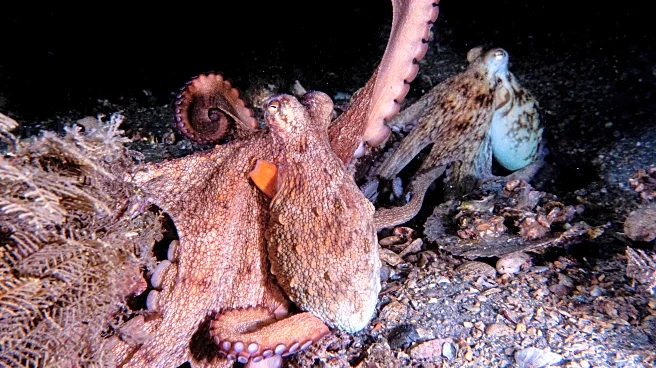What's Happening?
Researchers at the Marine Biological Laboratory in Woods Hole, US, have conducted a comprehensive study on octopus arm usage, revealing that these cephalopods prefer using their front arms for most tasks. The study, published in Scientific Reports, analyzed 25 video clips of wild octopuses from three species, filmed across various habitats from Spain to the Cayman Islands. The researchers identified 15 different behaviors and 12 arm actions, noting that octopuses are capable of performing multiple actions simultaneously with any of their eight arms. Despite the flexibility of all arms, the study found a preference for front arms in actions such as reaching, raising, lowering, and curling, while rear arms were more often used for locomotion-related actions like stilt and roll.
Why It's Important?
The findings provide significant insights into the behavioral ecology of octopuses, highlighting their adaptability and coordination in using their limbs for complex tasks. This research not only advances understanding in marine biology but also has potential applications in other fields. The demonstrated flexibility and multitasking ability of octopus arms could inform the design of soft robotic appendages, offering inspiration for engineers and neuroscientists working on robotics and sensory technologies. Understanding octopus limb coordination may also contribute to ethological studies and sensory ecology, enhancing knowledge of animal behavior and adaptation.
What's Next?
The study opens avenues for further research into the neural mechanisms behind octopus arm coordination and preference. Scientists may explore how these findings can be applied to the development of advanced robotic systems that mimic the flexibility and adaptability of octopus limbs. Additionally, the research could lead to more detailed investigations into the sensory and ecological factors influencing arm usage in octopuses, potentially uncovering new aspects of their behavior and interaction with the environment.
Beyond the Headlines
The study's implications extend beyond marine science, touching on ethical and cultural dimensions in the use of animal behavior to inform technological advancements. As researchers and engineers draw inspiration from nature, considerations around the ethical treatment of animals and the cultural significance of biomimicry in technology development may arise. The study also highlights the importance of interdisciplinary collaboration in advancing scientific knowledge and innovation.













